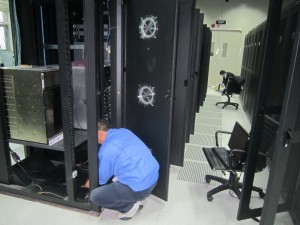China bids for supercomputer dominance, with a little help from abroad

SHENZHEN -- A newly built supercomputing center in the city of Shenzhen, next to China’s border with Hong Kong, is home to the world’s fourth fastest supercomputer. Housed in sleek looking black containers, the Nebulae supercomputer runs at over 1.2 petaflops per second, and has a storage capacity of 1.7 Petabytes, the largest of a single machine in the world, according to Lu Chuan, an engineer at Shenzhen's supercomputing center.
The Nebulae was built by Dawning Information Industry, a partly government-owned company which claims to manufacture a third of China’s supercomputers. Dawning sees the Nebulae as a business venture, Lu said. “We make money by renting the Nebulae’s processing abilities to other companies,” he said. Local automobile firm BYD has used the Nebulae to run crash simulations, and Beijing Genomics, a local biotech firm, used the computer for genome sequencing. But the company needs to attract more customers, as less than 50% of Nebulae’s processing capacity is usually in use at any one time, Lu said.
Lu is one of forty engineers who operate the Nebulae. Most of the engineers are recent post-graduates in their twenties. “As far as I know, there aren’t any women working here,” Lu said.Despite the commercial ambitions of the center, the government is heavily involved in leading the project “A Shenzhen city government official is head of the center,” Lu said.

Most of the computers processing chips were made by Intel, alongside Graphics Processors made by US firm NVIDIA. Chinese Chips, account for about one percent of the computer’s processors, Lu said. “Greater use of Chinese made chips is the future of supercomputer development,” he said.
That seems to have been proved already by China’s newest supercomputer, The Tianhe-A1, unveiled last October. The Tianhe-A1 runs on Chinese-made "Shenwei 1600" chips, and has about one third more processing power than the Nebulae. But the Shenwei chips are based on decade-old US technology, according to a recent report in Science magazine. “Chinese chips are still behind foreign chips technologically,” Lu said.
China has made fast progress in supercomputer development, and is now home to more supercomputers than any other country. As well as Shenzhen, there are three other supercomputing centers in China, one in Shanghai, and two the Northern Chinese cities of Tianjin and Jinan. Another is currently under construction in the central Chinese city of Changsha. “Since our center is close to Hong Kong and Macau, we want to attract customers from outside the mainland” Lu said.
Cloud Computing is one possible use for the Nebulae’s processing power, and Dawning has developed its
own cloud operating system in the hope of attracting customers. The Company’s CEO announced his plan to change the direction of his firm away from hardware to cloud computing, which he calls “the fourth IT revolution,” a measure of how much faith Chinese IT leaders are putting in the cloud.
Tons of water used to cool the Nebulae’s metal housing are stored in tanks on the supercomputing center’s roof. At lunchtime, the engineers tramp over to a university-style dining hall, piling their trays with meat and rice, and slurping from cartons of milk. “Within 2 years, China will have a computer twice as fast as the Nebulae,” Lu said. That still won’t be as fast as the world’s current top supercomputer, based in Japan. But the center of the supercomputing world has, in terms of numbers at least, moved east.
Pictures: Tom Hancock.
This post was originally published on Smartplanet.com
